Think of your garden as a fortress, needing constant defense against sneaky pest invaders. You’ve gotta adjust your pest control strategy year-round to keep plants thriving. Start with bi-weekly inspections, checking under leaves and in soil for tiny threats like aphids or mites. Grab a notebook, jot down findings with dates, and track patterns over time. Curious how seasons shift your game plan? Stick around for the breakdown.
Contents
Seasonal Pest Monitoring
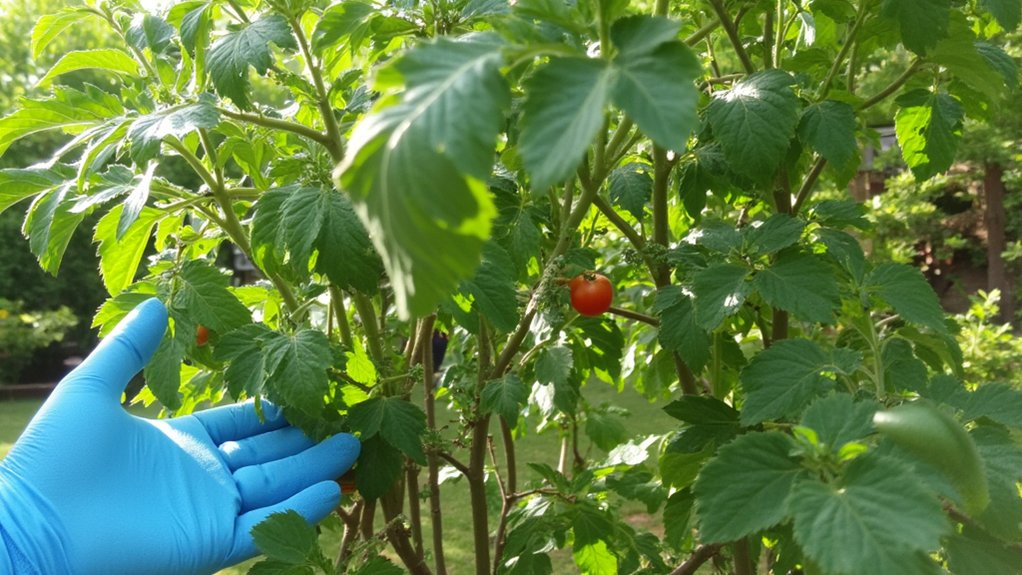
Although pests can sneak up on your plants any time, keeping a close eye on them with seasonal pest monitoring is your best defense. You’ve gotta stay proactive, checking your garden regularly for sneaky invaders. Set a schedule—every two weeks, walk through your plants, inspecting leaves and stems.
Look closely for tiny holes, sticky residue, or unusual spots on a 6-inch radius around each plant. If you spot something odd, jot it down with the date in a notebook. This helps track patterns over months, so you’re not caught off guard.
Don’t skip hidden spots like under leaves or near soil; pests love those hideouts. Stick to this routine year-round, and you’ll keep most critters at bay without much hassle.
Spring Pest Inspection
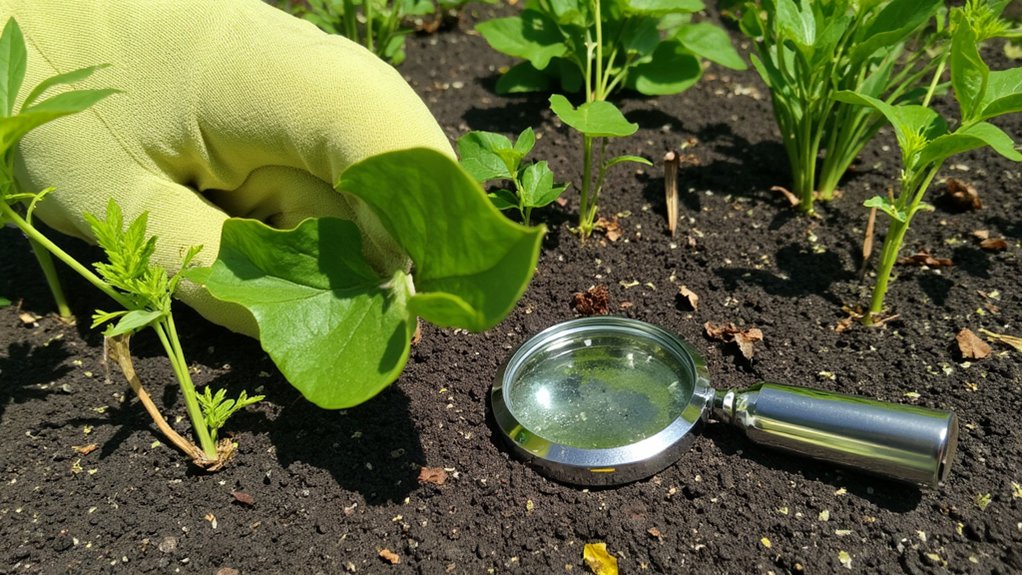
How do you kick off pest control when spring hits? Well, start by grabbing your gardening gloves and a magnifying glass. Inspect your plants closely, focusing on leaves, stems, and soil for tiny invaders. Look for signs like chewed edges or sticky residue, often under 1/8 inch in size.
Next, check every plant, especially new growth, since pests love tender shoots. Spend about 10-15 minutes per garden bed, doing this weekly in early spring. Note any unusual spots or bugs in a small notebook for tracking. This helps you spot patterns fast.
Don’t skip hidden areas, like under pots or near mulch. Pests hide there, waiting to strike. Stay consistent, and you’ll catch issues before they spiral outta control.
Early Spring Assessment
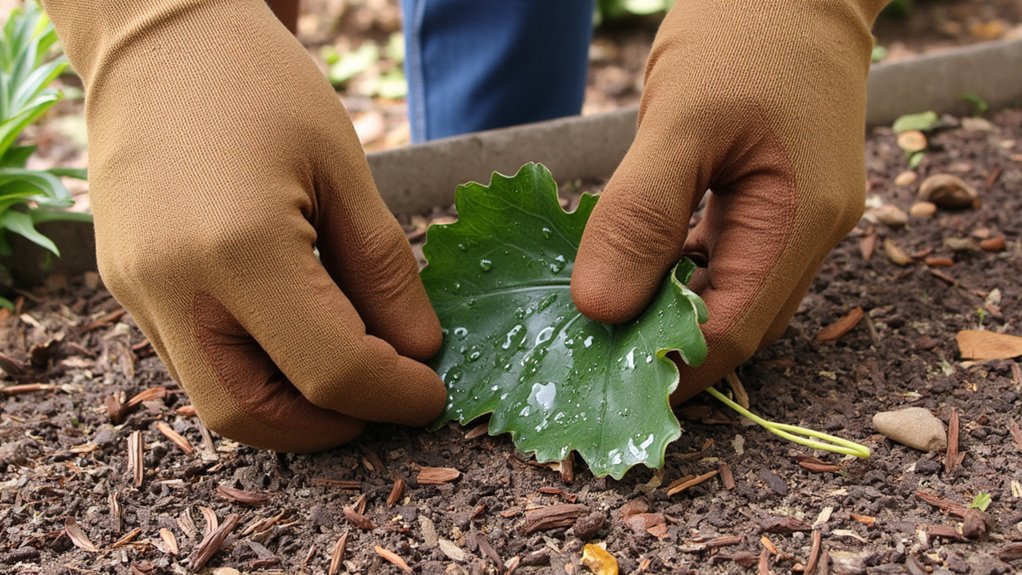
While spring brings new growth, it’s also prime time for pests to invade your garden. Don’t wait for damage to show up; start your early spring assessment now. Grab a notebook, and let’s get to work.
First, inspect your plants closely, especially around the base and under leaves. Look for tiny holes, chewed edges, or sticky residue on stems. Note any unusual signs within a 1-foot radius of each plant.
Next, check your soil for grubs or larvae by digging 2-3 inches deep near roots. Do this within the first week of spring, ideally mid-March. Record everything—dates, locations, findings—to track patterns. Finally, clear debris like fallen leaves or twigs; they’re pest hideouts. Stay proactive, and you’ve got this!
Spring Aphid Check
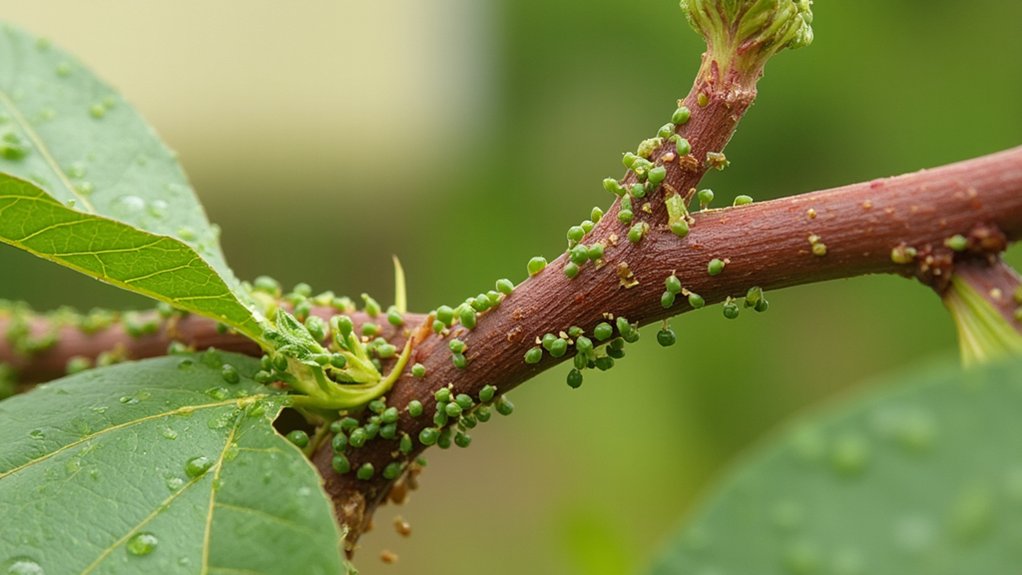
Let’s zero in on a common spring nuisance: aphids. These tiny, sap-sucking pests, often green or black, can wreak havoc on your plants. They multiply fast, so you’ve gotta act quickly.
Start by inspecting your garden weekly, especially in early spring. Look under leaves and along stems for clusters of these 1-2 millimeter bugs. If you spot them, don’t wait—grab a hose and blast them off with a strong stream of water.
Next, mix a solution of 1 teaspoon dish soap with a quart of water. Spray it directly on affected areas, ensuring full coverage, to disrupt their feeding. Repeat every 2-3 days until they’re gone. Stay vigilant, as aphids can return if you slack off.
Spring Pest Prevention

After tackling those pesky aphids, turn your attention to preventing other spring pests from invading your garden. Spring brings warmth, sure, but it also wakes up critters like beetles and caterpillars. You’ve gotta act fast to protect your plants.
Start by inspecting your garden beds every three days, especially around early March. Look under leaves and near stems for tiny eggs or chew marks, which signal trouble. If you spot anything, remove it manually with gloved hands, dropping pests into soapy water.
Next, set up barriers like floating row covers over young plants. Secure them tightly with rocks or stakes, ensuring no gaps wider than half an inch. Check weekly for tears. This keeps pests out while letting sunlight in, safeguarding your spring growth.
Spring Slug Patrol
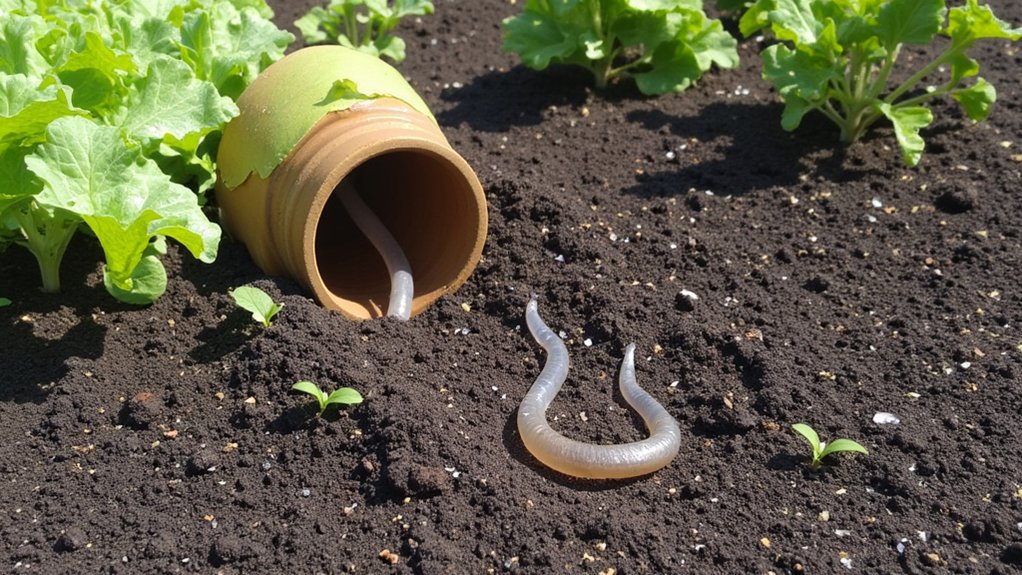
As spring rolls in, you’ve gotta keep an eye out for slugs, those slimy little garden wreckers. They thrive in damp, cool weather, munching on tender leaves overnight. Look for silvery trails on soil or plants at dawn.
Start your patrol by checking under rocks, pots, and mulch—slugs hide there during the day. Set up traps with shallow dishes of beer, sunk to ground level, about 3 inches wide. Place them near affected areas, and check every morning. Empty and refill as needed.
You can also sprinkle diatomaceous earth, a fine powder, around plants in a 2-inch barrier. It’s sharp to slugs, deterring them without chemicals. Reapply after rain, and keep inspecting weekly to stay ahead of infestations.
Spring Beetle Surveillance
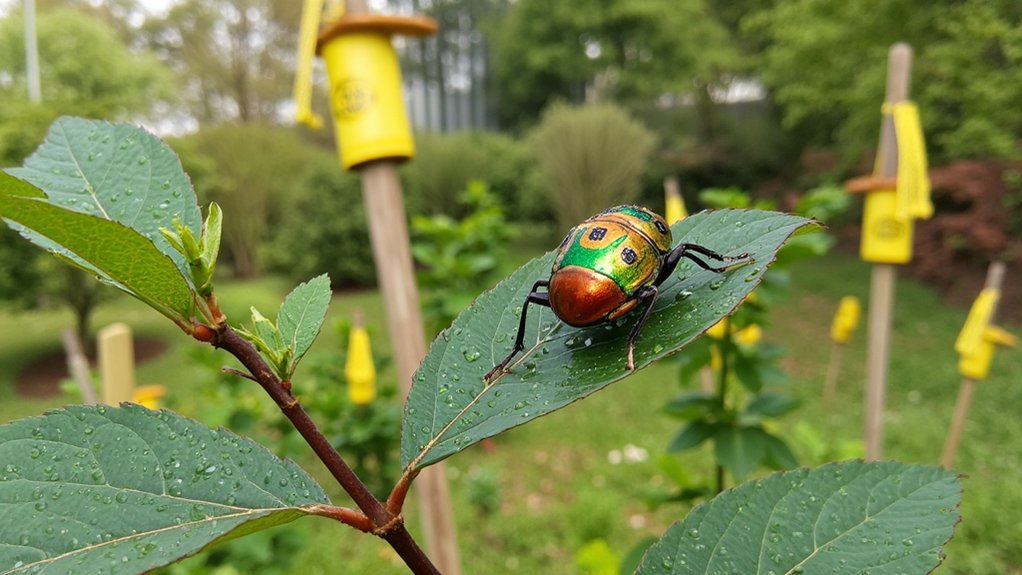
Keep your garden defenses up, since slugs aren’t the only pests waking up in spring. Beetles, like the pesky Japanese beetle or flea beetle, emerge now, hungry for your tender plants. You’ve gotta act fast to spot ‘em.
Start your surveillance by checking leaves daily, especially in early morning, around 7 a.m., when beetles are less active. Look for tiny holes or shiny, metallic bugs, about ½ inch long, on roses or veggies. If you see ‘em, pick ‘em off by hand into a bucket of soapy water—use 1 tablespoon of dish soap per gallon.
Also, set up yellow sticky traps, 3 feet above ground, near affected areas. Check traps weekly, replacing ‘em if they’re full. Stay vigilant, and you’ll keep those beetles in check!
Spring Caterpillar Watch
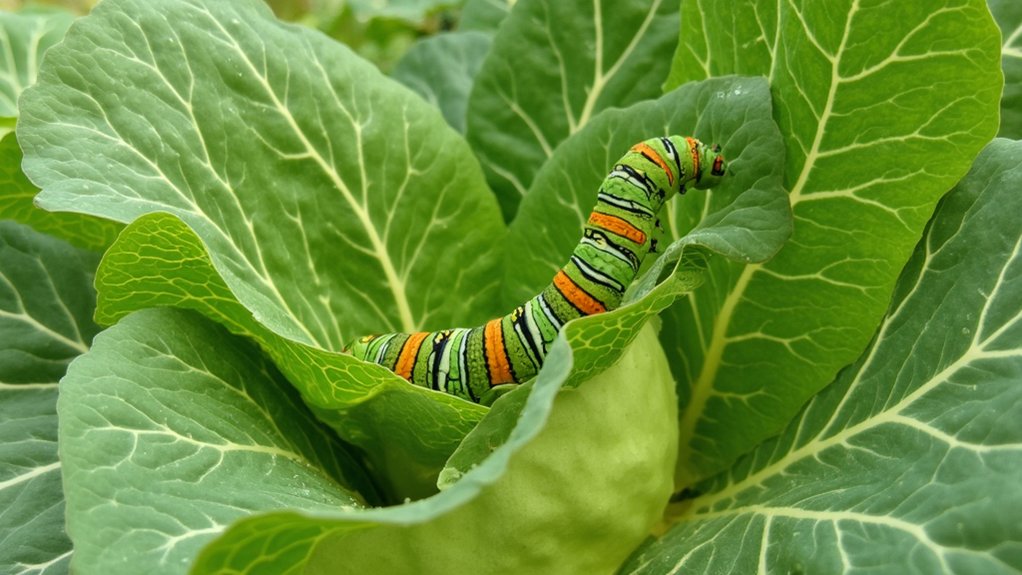
Ever wonder what’s munching on your plants when you’re not looking? In spring, caterpillars are often the culprits, chomping through leaves fast. These little pests, like the cabbage looper or tent caterpillar, can strip foliage overnight if you’re not careful.
Keep an eye out starting early March, especially on new growth. Inspect your plants every 3-4 days, checking under leaves for tiny eggs or small, green worms. If you spot them, don’t wait—pick them off by hand or use a garden hose to blast them away.
For bigger infestations, grab a natural pesticide like Bacillus thuringiensis (Bt), applying it as directed, usually 1 teaspoon per gallon of water. Spray in the evening to target active caterpillars, protecting your plants efficiently.
Spring Whitefly Monitoring
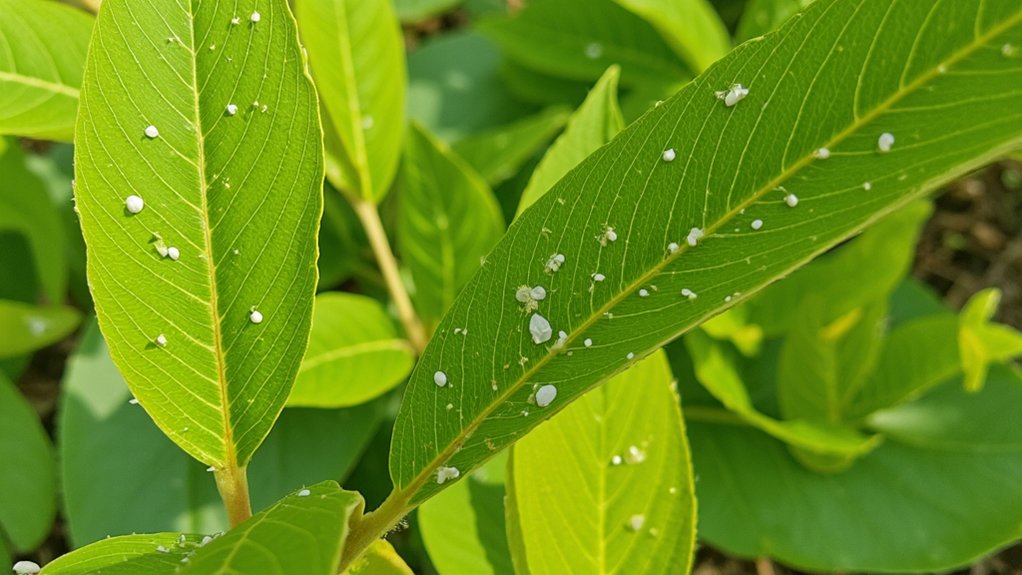
Spotting caterpillars in spring is just one battle, but now you’ve gotta watch for another sneaky pest. Whiteflies, tiny sap-suckers, can wreak havoc on your plants. They’re about 1/16 inch long, white, and often hide under leaves.
Start monitoring in early spring, around mid-March, when temperatures hit 60°F. Grab a magnifying glass, check the undersides of leaves, and look for small, powdery clusters or sticky residue. If you spot ‘em, act fast—shake the plant gently to see if tiny white specks fly up.
Set up yellow sticky traps, about 6 inches above the soil, to catch adults. Check traps weekly, and replace ‘em if they’re covered. Keep at it through late spring, ensuring your plants stay safe from these pesky invaders.
Spring Mite Detection

While you’re on pest patrol this spring, don’t overlook mites, those microscopic menaces that can damage your plants fast. They’re tiny, often under 1 millimeter, and hide on leaf undersides, sucking sap and causing yellow speckles. Check your plants weekly, especially roses and tomatoes, for early signs.
Grab a magnifying glass, ideally 10x power, and inspect leaves closely for webbing or moving dots. If you spot trouble, act quick—mix a solution of 1 teaspoon dish soap with 1 quart of water. Spray it on affected areas every 3 days for a week, ensuring full coverage.
Don’t wait for damage to spread; mites multiply rapidly in warm weather. Keep monitoring through spring, and you’ll stay ahead of infestations.
